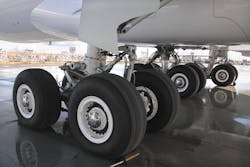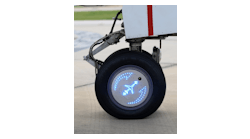The Business of Wheel and Brake MRO
One of the often overlooked, and certainly the least glamorous area of aircraft are the wheels and brakes. Essential to the start and finish of each flight and of course all ground movements, these expensive assets undergo tremendous force, environmental and temperature variances on each and every flight.
The regional and commercial aircraft wheel and brake market is dominated by four OEMs, namely: Honeywell, UTC Aerospace, Meggitt, and Messier-Bugatti-Dowty. All products follow a similar construction, although boltless wheels are becoming more popular now, as are carbon brakes.
Understanding the maintenance cycle
Wheels and brakes are normally removed from the aircraft “on condition”, either when the tyre tread or brake friction material is worn to limit. This limit is ascertained by line maintenance staff, and the entire wheel/tyre assembly or brake is then routed to a workshop for refurbishment. A tyre can be changed on an aircraft wheel several times before a full overhaul of the wheel is required; similarly the friction material in a brake is replaced several times before a full overhaul is required.
Tyre change (minor service) requires basic disassembly, cleaning and inspection of the wheel before a fresh tyre is fitted, the wheel reassembled and bearings greased. A wheel overhaul (major service) requires complete disassembly, paint removal, comprehensive NDT, and visual/dimensional inspection, before new paint is applied and the wheel built for return to service. The cost difference between tyre change and overhaul is considerable, and the maintenance schedule is written to permit a safe number of tyre changes before overhaul. Brakes follow a similar process, based on the OEM’s recommendations.
This cycle of minor/major inspections is often poorly understood by operators with many just carrying out multiple tyre changes without overhaul, which presents an airworthiness risk but more commonly results in a higher number of irreparable units due to corrosion that has gone unnoticed. With the extremes in environmental conditions experienced by wheels and brakes, corrosion is a major problem and it is only on overhaul that the opportunity exists to monitor, remove, and protect against corrosion. A Boeing 737-300 wheel, for example, might require an overhaul every five tyre changes, based on an average tread life of 275 cycles per tyre tread. A more modern aircraft, such as Embraer E190 series, for example, requires an overhaul every other tyre change due to the fact that tyre life regularly exceeds 850 landings per tyre tread. These limits, essentially based on total cycles or calendar limits, are in place to ensure the wheel is maintained on an acceptably regular basis.
Operation affects shop inputs
It can be seen therefore that there is a direct correlation between traffic numbers and shop inputs for wheels and brakes. Numbers however also fluctuate hugely depending on the seasons, not just down to operators’ schedules but the conditions in which the aircraft are operating. A northern hemisphere summer for example brings an increase in holiday traffic boosting flights and thus wheel and brake removals. But also hot conditions with hot runways, heavier aircraft, or tighter turnarounds – all of which reduce the life of the tyres and to a lesser extent, the brakes. Different routes can have a heavy impact on removals; runway conditions and manoeuvring area dimensions can make one route’s tyre consumption vastly different from another. Contrary to opinion, it isn’t the spin-up of the tyre on landing releasing the puff of smoke that wears the tyre, it is more the sharp turns made by the aircraft during ground manoeuvres that causes the most wear. Aircraft that operate tight schedules into inner city airports with very compact ramp areas see far less tread life than those operating into larger airports.
As aircraft numbers increase, there is an upward shift in the number of wheels and brakes flying, and thus requiring servicing. However, as tyre and brake technology improves, the “on-wing” life of wheel and brake units is increasing massively, as shown in the above Boeing 737 versus Embraer E190 example, so the actual shop inputs worldwide has plateaued in recent times. These technological advances are brought about by the introduction of radial tyres and carbon heat-packs, which are standard equipment on all new aircraft types. However, there is still great longevity in legacy aircraft, which rely on proven, unchanging technology for wheel and brake units.
The wheel and brake MRO market is dominated by the OEMs who have their own repair shops in central locations around the world. The huge cost of development, testing, and certification of wheels and brakes, coupled with the fact that many OEMs often provide the actual wheels and brakes free-of-charge to an aircraft purchaser, mean that in-service support is the only way to recoup the cost of bringing a wheel and brake product to market.
The cost of development is recovered through the supply of spares or through the supply of MRO services, and thankfully for the OEMs, as wheels (and especially brakes) have many consumable parts, the opportunity for spares supply is great and constant. The OEMs are very keen to support the major operators, particularly those with large fleets fitted with one OEM specified wheel and brake type.
The Independent MRO
The wheel and brake MRO market, although dominated by the OEMs and airlines that have invested in their own workshops at the larger scale of operations, is a thriving sector of the MRO business and is well represented worldwide by many independent workshops.
World Aero is one such independent wheel and brake MRO. Based in the UK, we were formed in 1999, obtaining EASA Part-145 approval in 2008, and subsequently TCCA and FAA approvals. Focussed largely on Boeing 737 and A320 product, we invest in equipment, facilities, and manpower to deliver large volumes of consistently high quality product. Our location close to London means we are well placed to support a large number of aircraft.
In the highly competitive wheel and brake industry, we have found that in order to stay ahead we must make good use of lean processes – delivering more product on less resource, whilst still maintaining high quality levels. We have learned that investment in tooling and equipment is key to success, to enable technicians to perform their tasks in a straightforward and productive manner. We train our employees in-house so that efficiencies in production are instilled from the outset – a measure which we hope will lead to long-term steady growth for the company.
Indeed, from working on 500 units in 2009, we repaired more than 3,400 units in 2015, with some 92 percent of these being full overhauls. We feel that such growth is only possible with a steady, long-term business model. Wheel and brake maintenance is straightforward, and done properly, should be the last item on the aircraft to cause an operator technical or financial worries.
Going forward, it is accepted that the OEMs will always seek to support the larger, flagship carriers that run only their product. However, there is a growing market of smaller airlines, and those that operate a mixed fleet of wheels and brakes, where the independent MRO can provide a good service more suited to that operation. And it’s not just airlines, there is a market of course in business aviation, although the small size and straightforward maintenance of those wheels and brakes means a lot more can be done by aircraft MROs without needing the support of specialist workshops.
Every time an aircraft takes off or lands it is getting one step closer to needing work from a wheel and brake MRO. A variety of workshops offer solutions to meet every operator’s needs and whilst none are trying to “re-invent the wheel,” independence brings flexibility.
Phil Randell is World Aero’s managing director and accountable manager. An EASA Part-66 licensed aircraft engineer, he has experience with base and line maintenance for a variety of airlines and has also assisted with start-ups and maintenance contracts. Established in 1999, World Aero is an expert in aircraft wheels and brakes, providing aircraft wheel and brake component repair, overhaul, parts sales, parts exchange, and inventory management for international aviation customers; from commercial airline fleets to corporate jets. World Aero is a multi-release EASA, FAA, and additionally TCCA certified repair station.






